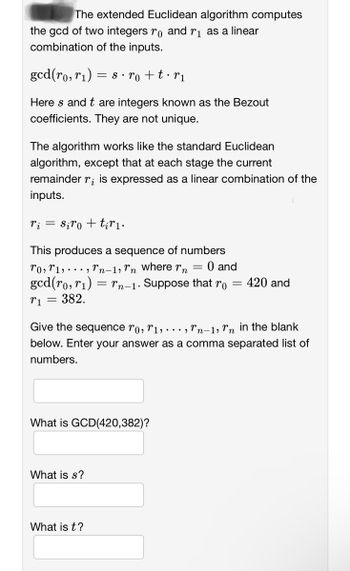
Advanced Engineering Mathematics
10th Edition
ISBN: 9780470458365
Author: Erwin Kreyszig
Publisher: Wiley, John & Sons, Incorporated
expand_more
expand_more
format_list_bulleted
Question

Transcribed Image Text:The extended Euclidean algorithm computes
the gcd of two integers ro and r₁ as a linear
combination of the inputs.
gcd(ro, r₁) = s.ro + t •rı
Here s and t are integers known as the Bezout
coefficients. They are not unique.
The algorithm works like the standard Euclidean
algorithm, except that at each stage the current
remainder
ri is expressed as a linear combination of the
inputs.
ri = siro + tir₁.
This produces a sequence of numbers
To, T1,
Tn-1, Tn where r = 0 and
gcd(ro, r₁) = Tn-1. Suppose that ro = 420 and
T1 = 382.
Give the sequence ro, T1,..., Tn-1, în in the blank
below. Enter your answer as a comma separated list of
numbers.
What is GCD(420,382)?
What is s?
What is t?
Expert Solution
This question has been solved!
Explore an expertly crafted, step-by-step solution for a thorough understanding of key concepts.
This is a popular solution
Trending nowThis is a popular solution!
Step by stepSolved in 4 steps with 55 images

Knowledge Booster
Learn more about
Need a deep-dive on the concept behind this application? Look no further. Learn more about this topic, advanced-math and related others by exploring similar questions and additional content below.Similar questions
- Please do the following questions with full handwritten working outarrow_forwardFind an inverse for the linear congruence 9x = 15 (mod 23) by using the Euclidean algorithm to compute the gcd(9, 23) and performing backward substitution. Then find a solution for the linear congruence.arrow_forward3) Use the Euclidean algorithm to compute gcd(428, 484).arrow_forward
- Someone used the Euclidean Algorithm to compute gcd(44,140) and found the following. Use this to write the gcd as a linear combination of 44 and 140. Show work. 140 = 3(44) + 8 44 = 5(8) + 4 8 = 2(4) + 0arrow_forward(a) Use the Euclidean algorithm to find gcd(131,326). (b) Use the above to find a solution to 131x+326y=gcd(131,326) (c) Does 131 have an inverse modulo 326? If so, find a value in {0,1,2,3,…,325} that is an inverse. If not, explain why not?arrow_forwarda) (123mod 19 ▪ 342 mod 19) mod 19 b) (12² mod 17)³ mod 13 2) (10 pts) Prove or disprove that for all integers a, b, and c, if alb and b/c then alc.arrow_forward
arrow_back_ios
arrow_forward_ios
Recommended textbooks for you
 Advanced Engineering MathematicsAdvanced MathISBN:9780470458365Author:Erwin KreyszigPublisher:Wiley, John & Sons, Incorporated
Advanced Engineering MathematicsAdvanced MathISBN:9780470458365Author:Erwin KreyszigPublisher:Wiley, John & Sons, Incorporated Numerical Methods for EngineersAdvanced MathISBN:9780073397924Author:Steven C. Chapra Dr., Raymond P. CanalePublisher:McGraw-Hill Education
Numerical Methods for EngineersAdvanced MathISBN:9780073397924Author:Steven C. Chapra Dr., Raymond P. CanalePublisher:McGraw-Hill Education Introductory Mathematics for Engineering Applicat...Advanced MathISBN:9781118141809Author:Nathan KlingbeilPublisher:WILEY
Introductory Mathematics for Engineering Applicat...Advanced MathISBN:9781118141809Author:Nathan KlingbeilPublisher:WILEY Mathematics For Machine TechnologyAdvanced MathISBN:9781337798310Author:Peterson, John.Publisher:Cengage Learning,
Mathematics For Machine TechnologyAdvanced MathISBN:9781337798310Author:Peterson, John.Publisher:Cengage Learning,


Advanced Engineering Mathematics
Advanced Math
ISBN:9780470458365
Author:Erwin Kreyszig
Publisher:Wiley, John & Sons, Incorporated

Numerical Methods for Engineers
Advanced Math
ISBN:9780073397924
Author:Steven C. Chapra Dr., Raymond P. Canale
Publisher:McGraw-Hill Education

Introductory Mathematics for Engineering Applicat...
Advanced Math
ISBN:9781118141809
Author:Nathan Klingbeil
Publisher:WILEY

Mathematics For Machine Technology
Advanced Math
ISBN:9781337798310
Author:Peterson, John.
Publisher:Cengage Learning,

